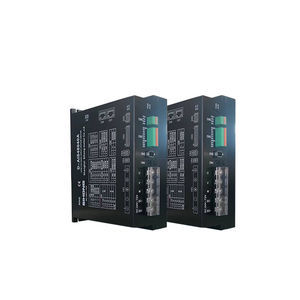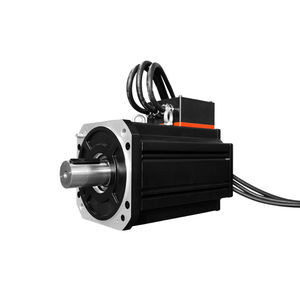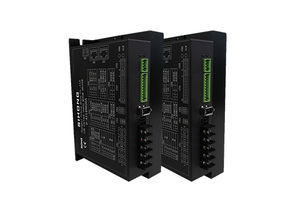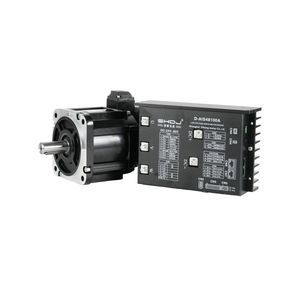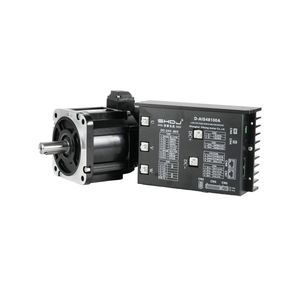
- Mécanique - Transmission de puissance
- Moteur et Contrôle Moteur
- Servo-variateur DC
- Shanghai Siheng Motor Co., Ltd
- Produits
- Catalogues
- News & Trends
- Salons
Servo-variateur DC D – AIS72200AModbusRS-485de commande
Ajouter à mes favoris
Ajouter au comparateur
Caractéristiques
- AC/DC
- DC
- Signal de sortie
- RS-485, Modbus
- Applications produits
- de commande, de positionnement
- Autres caractéristiques
- compact, haute performance, à contrôle de couple, intelligent, basse tension, intelligent, multifonction
- Intensité
Min: 8 A
Max: 300 A
Description
Product DetailsIt features high stability, high positioning accuracy, high drive response, low noise, low heat generation, well-structured design, strong overload capacity, practical and rich functions, and simple and convenient application. It has protections against over-voltage, under-voltage, overspeed, over-current, overload, encoder anomalies, position deviation, stalling, parameter anomalies, etc.Technical SpecificationsDriver ModelVoltage Range (V)Rated Current (A)D – AIS24008A24 – 368D – AIS48015A24 – 4815D – AIS48025A24 – 6025D – AIS48050A24 – 7250D – AIS48100A36 – 72100D – AIS72200A48 – 96200D – AIS72300A48 – 96300Control Method① Position control ② Speed control ③ Torque control ④ Communication controlControl FeaturesSpeed frequency response: ≥200Hz, Received pulse frequency ≤200kHz, Speed fluctuation rate: < ±0.03 (Load 0 – 100%): < ±0.02×(0.9 – 1.1) Supply voltageMonitoring FunctionCurrent speed, DI input, DO output, Current position, Accumulation of command input pulses, Average load rate, Number of position deviations, Motor phase current, Bus voltage value, Module temperature, Alarm record, Command pulse frequency Corresponding speed, Operating status, etc.Home – Return Function13 Types of home (search) return modes, and Home – Point offset functionRs485 FunctionFollows standard Modbus – Rtu protocol, One – to – Two Two – Communication interface for easy networking and parallel connectionDriver Installation DimensionsProduct model: D – AIS72200ARated voltage: 48 – 96VRated current: 200ASplit – type Driver Hardware InterfaceApplicable drive models: D – AISXX005A / D – AISXX0015A / D – AISXX0025A / D – AISXX0040A / D – AISXX00100A / D – AISXX00200ASplit – AI Motor Drive Interface DiagramSerial NumberSymbolFunctionRemarksCN11UMotor U – phaseJVW interface power cable for motor adaptation2VMotor V – phase3WMotor W – phase4DC –Negative pole of input power supplyExternal DC input power must distinguish positive and negative poles; voltage range: DC48V5DC+Positive pole of input power supplyCN215V+Motor encoder power interfacePower interface for adapting motor encoder2GNDPower interface3NCEmpty terminalNo function4NCEmpty terminalNo function5SD+Motor encoder communication interfaceCommunication interface for adapting motor encoder6SD –CN31DI – COMCommon terminal for input signalsCommon terminal for all DI input signals. When DI – COM is connected to the positive pole, negative DI control is effective; when IN – COM is connected to the negative pole, positive DI control is effective2DI1Input signal terminal 1Factory default function: Servo enable3DI2Input signal terminal 2Factory default function: Alarm reset4DI3Input signal terminal 3Factory default function: Emergency stop5DI4Input signal terminal 4Factory default function: JOG positive jogging6DI5Input signal terminal 5Factory default function: JOG negative jogging7DO – COMCommon terminal for output signalsCommon terminal for all DO output signals. When DO – COM is connected to the positive pole, positive DO action is effective; when DO – COM is connected to the negative pole, negative DO action is effective8DO1Output signal terminal 1Factory default function: Servo ready9DO2Output signal terminal 2Factory default function: Fault alarm output10DO3Output signal terminal 3Factory default function: Positioning completion outputCN41BRK+Brake output positive poleInterface for adapting the motor's mechanical brake2BRK –Brake output negative poleReference Table for Brake Resistor Selection for Split – type Driver Interface Cn9Split – type Driver ModelRated Output CurrentExternal Brake Resistor Value RequirementExternal Brake Resistor Power RequirementD – AISXX008A8A10 ohms – 30 ohms rangeAbove 100WD – AISXX0015A15A10 ohms – 30 ohms rangeAbove 100WD – AISXX0025A25A10 ohms – 30 ohms rangeAbove 100WD – AISXX0050A50A5 ohms – 15 ohms rangeAbove 200WD – AISXX00100A100A5 ohms – 15 ohms rangeAbove 200WD – AISXX00200A200A5 ohms – 15 ohms rangeAbove 200WStandard Wiring DiagramInput Power WiringNote 1: Input power terminals must strictly distinguish positive and negative poles. The input power voltage range may vary by model. Please refer to the hardware interface reference wiring for the corresponding model in the previous chapter.Note 2: This product has a certain overload capacity. When selecting an external switching power supply, the output capacity should be 1.5 times the rated current of this product. The product's rated current is indicated on the nameplate.High – Speed Pulse Signal WiringOpen Collector WiringDifferential Signal WiringNote 1: For different motors, the interface positions of the pulse input terminals may vary. Please refer to the hardware interface description for the corresponding model in the previous chapter.Note 2: This product supports pulse input with a wide voltage range of 5 – 24V, and the maximum received pulse frequency is 200 KHZ. The upper-level pulse device must ensure the frequency is limited to less than 200K to prevent the driver from easily losing pulses and causing positioning anomalies.Note 3: It is recommended to use double-shielded wires for pulse control lines and avoid laying them in the same circuit as strong current sources, which can effectively protect against strong external magnetic interference.Note 4: The above pulse connection methods must be consistent with the H05 – 15 parameters. The factory default setting for H05 – 15 is pulse + direction control mode.DI and DO WiringAT Input Terminal WiringNote 1: The input terminal control voltage is valid at DC12 – 24V.Note 2: Each DI can be freely assigned different functions (refer to section 4.2 DIDO parameter section), but the same function cannot be assigned to multiple DIs.Note 3: For external switching signal control with DC– input, select the NPN-type connection method, where low level is effective; for external switching signal control with DC+ input, select the PNP-type connection method, where high level is effective.DO Output Terminal WiringNote 1: The maximum driving capacity of the output terminals is <300mA current. If a large load needs to be carried, a relay must be used for conversion.Note 2: Each DO can be freely assigned different functions (refer to section 4.2 DIDO parameter section).Note 3: When controlling the DO port action, if DC– is output, select the NPN-type connection method, where low output level is effective; if DC+ is output, select the PNP-type connection method, where high output level is effective.RS485 Communication WiringMulti – Slave ConnectionNote 1: For multi-slave connection, if the communication signal noise is large, it is recommended to add a 120-ohm terminal resistor to the last slave to ensure communication quality.Note 2: For related communication content, refer to (section 4.5 RS485 – related parameters).Host Computer Debugging ConnectionNote 1: Generally, a computer does not have a direct 485 interface, and a USB-to-485 converter is required to connect to the slave drive.Note 2: The host computer debugging software for PC can be downloaded from our company's official website, which is convenient for users to debug.Model: D – AIS72200ARated voltage: 48 – 96VRated current: 200AControl methods: Position, speed, torque, communicationProtections: Over-voltage, under-voltage, overspeed, over-current, overload, encoder error, position deviation, stalling, parameter errorCommunication: RS485, Modbus RTU
Autres produits Shanghai Siheng Motor Co., Ltd
Servomoteur et pilote DC divisés
Recherches associées
- Moteur électrique
- Moteur de véhicule
- Moteur à courant continu
- Moteur AC
- Moteur synchrone
- Moto-réducteur électrique
- Moteur pour applications industrielles
- Moto-réducteur DC
- Moteur BLDC
- Moteur 24 V
- Moto-réducteur industriel
- Moto-réducteur électrique coaxial
- Moto-réducteur électrique planétaire
- Servo-amplificateur
- Servomoteur électrique
- Moto-réducteur orthogonal
- Moto-réducteur électrique AC
- Moteur pas à pas
- Moteur 220 V
- Servomoteur AC
* Les prix s'entendent hors taxe, hors frais de livraison, hors droits de douane, et ne comprennent pas l'ensemble des coûts supplémentaires liés aux options d'installation ou de mise en service. Les prix sont donnés à titre indicatif et peuvent évoluer en fonction des pays, des cours des matières premières et des taux de change.




